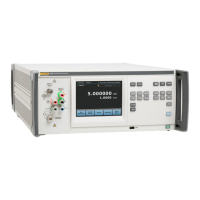Remote Commands
Checking Product Status 6
6-75
Status Byte Register (STB)
The most important and frequently used register is the Status Byte Register
(STB), which the Product sends when it responds to a serial poll. This byte is
cleared (set to 0) when the power is turned on. Its bits are defined as follows (bits
1 and 0 are always 0). See Table 6-9.
Table 6-9. Status Byte and SRE Bit Definitions
7 6 5 4 3 2 1 0
RID
RQS
ESB MAV EAV ISCB 0 0
MSS
RID Remote Idle. Set to 1 when the remote interface waits for input.
RQS
Requesting Service. The RQS bit is set to 1 when bits ESB, MAV, EAV, or ISCB change
from 0 to 1 and are enabled (1) in the SRE. When RQS is 1, the Product asserts the
SRQ control line on the IEEE-488 interface. You can do a serial poll to read this bit to
see if the Product is the source of an SRQ.
MSS
Master summary status. Set to 1 whenever bits ESB, MAV, EAV, or ISCB are 1 and
enabled (1) in the SRE. This bit can be read using the *STB? command in
serial/USB/Ethernet remote control in place of doing a serial port.
ESB Set to 1 when one or more enabled ESR bits are 1.
MAV
Message available. The MAV bit is set to 1 when data is available in the Product IEEE-
488 interface output buffer.
EAV
Error available. An error has occurred and an error is available to be read from the error
queue by using the ERR? query.
ISCB One or more enabled ISCR bits are 1.
If you are using the RS-232C, USB or Ethernet port as the remote control
interface, transmitting the ^P character returns the SPLSTR and the status byte.
Also refer to the *STB? command for more information.

